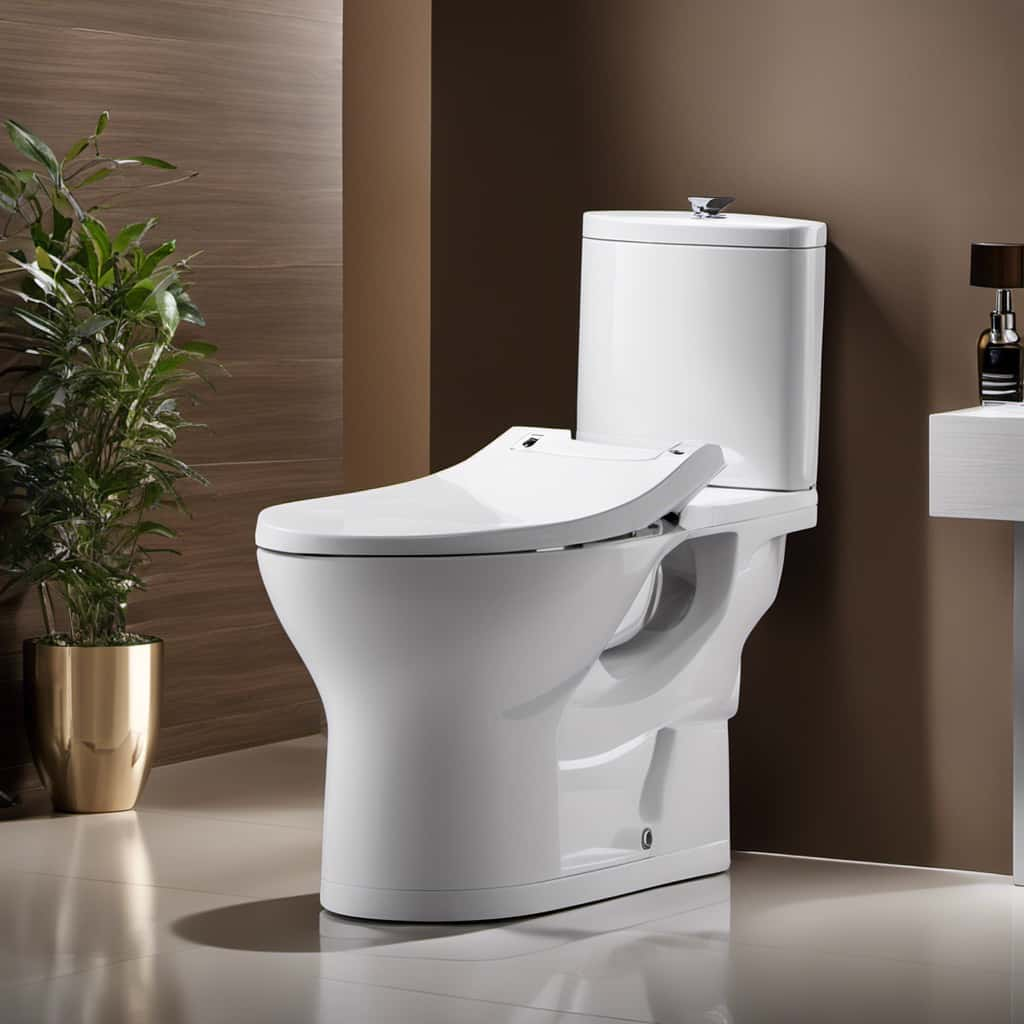Ever pondered the final destination of water after a toilet flush? Let’s peel back the curtain on that secret.
From the moment you press that lever, a fascinating journey begins. Our waste travels through the sewer system, navigating a complex maze of pipes. It eventually joins forces with a combined sewer system, where solids are filtered out.
After undergoing the final stages of disinfection and chlorination, the treated water is released back into nature.
Stay tuned as we explore this cycle, promoting water conservation and reuse.

Key Takeaways
- Flushed toilet water initiates the journey of wastewater from the toilet bowl.
- Proper plumbing maintenance is essential for the smooth flow of wastewater.
- The sewer system plays a crucial role in transporting and treating wastewater.
- Sewage can cause water pollution, contaminating water sources.
The Journey Begins: From Your Toilet Bowl
When we flush the toilet, the water immediately starts its journey from our toilet bowl. This is the first step in the process of transporting the wastewater from our homes to the sewer system.
The importance of proper plumbing maintenance can’t be emphasized enough in ensuring the smooth flow of this journey. From the toilet bowl, the wastewater is guided through a series of pipes that make up the plumbing system in our homes. These pipes are specifically designed to carry the wastewater away from our living spaces and into the sewer system.
It’s crucial to maintain these pipes in good condition, as any blockages or leaks can disrupt the flow, leading to potential backups and costly repairs. Regular inspections and timely repairs are essential to prevent any issues and maintain the efficiency of the wastewater transport system.
Into the Depths: the Sewer System
Now let’s take a closer look at the sewer system and how it handles our flushed toilet water.
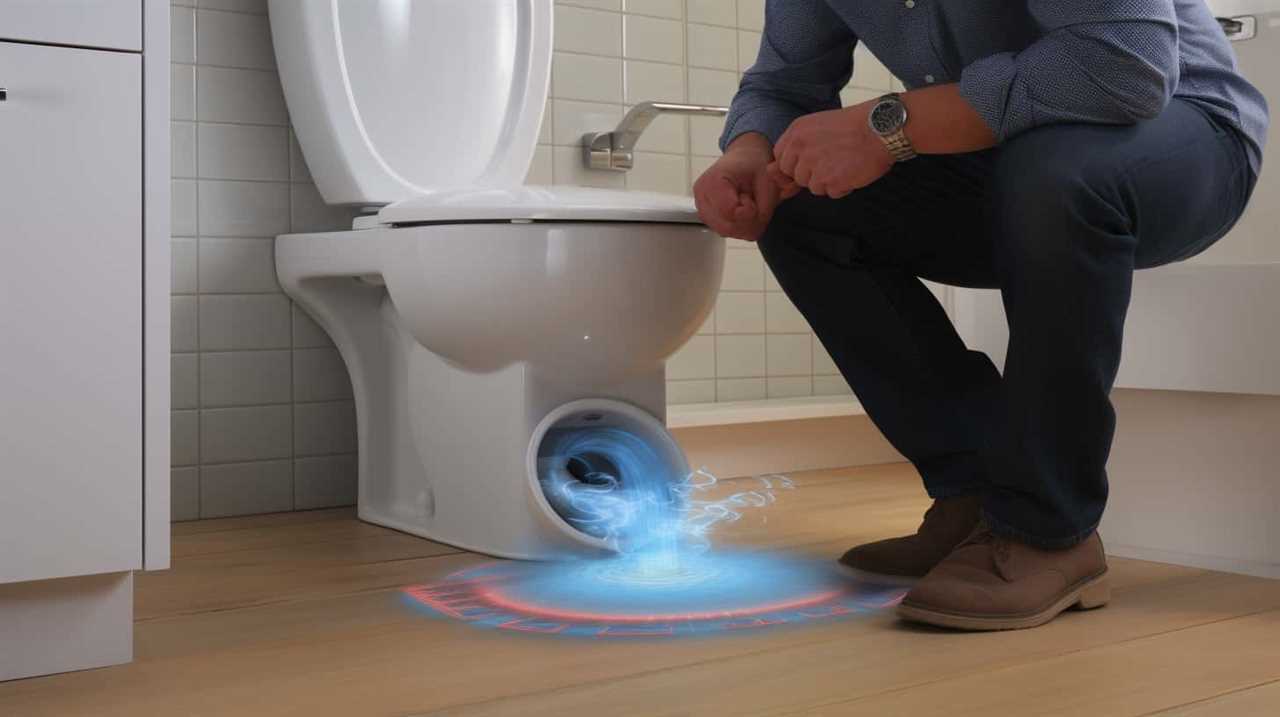
The sewer system plays a crucial role in the waste treatment process, ensuring that the sewage is transported efficiently and safely.
Understanding the environmental impact of sewage is also important, as it can have significant consequences on our ecosystems.
Waste Treatment Process Explained
After leaving our homes, flushed toilet water enters the waste treatment process through the sewer system. This process is crucial for ensuring the safe disposal of waste and minimizing its impact on the environment, particularly marine life.
The waste treatment process involves several steps, including screening, primary treatment, secondary treatment, and disinfection. During screening, large objects and debris are removed to prevent clogging and damage to equipment. In the primary treatment stage, solid waste is settled out and removed. Secondary treatment then utilizes bacteria to break down organic matter further. Finally, disinfection eliminates harmful pathogens before the treated wastewater is released back into the environment.
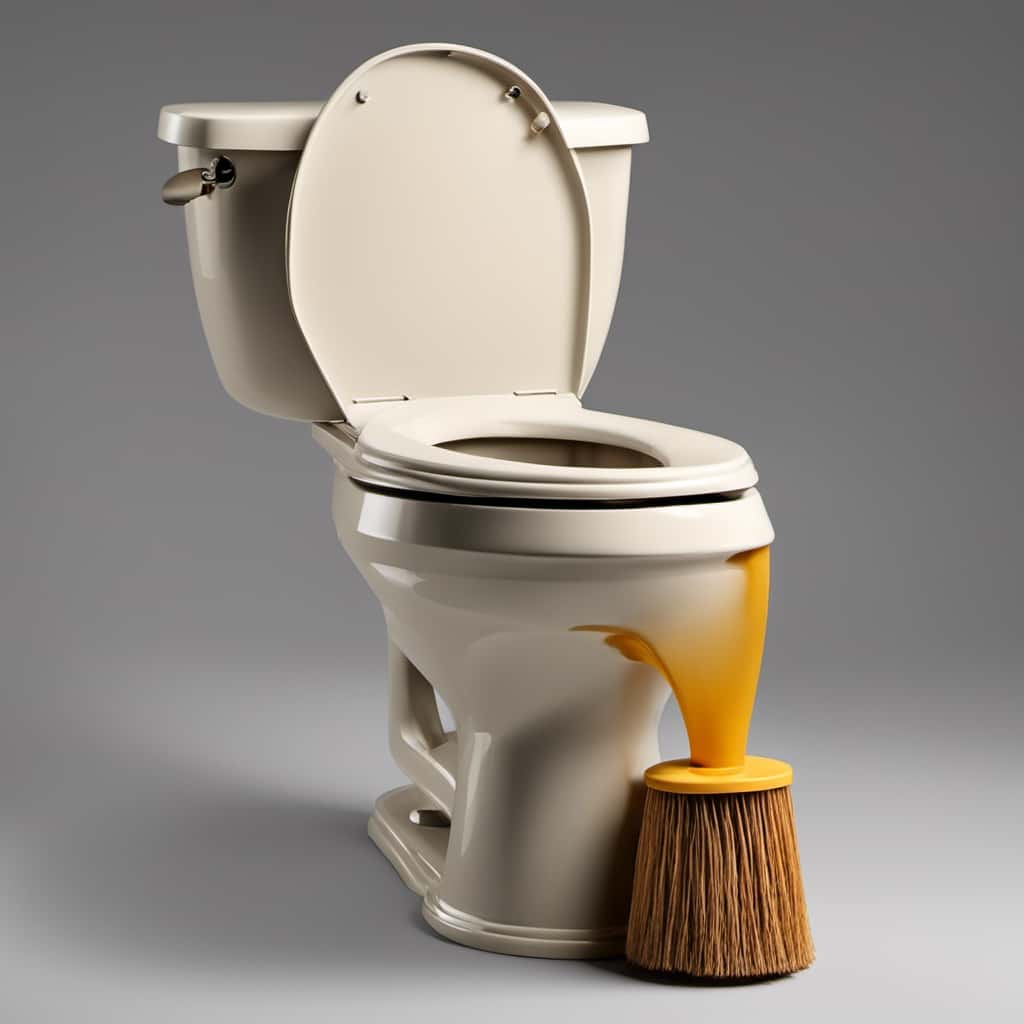
This comprehensive approach to waste treatment helps protect our ecosystems and safeguard the health of marine life.
Transitioning into the next section, let’s explore the environmental impact of sewage.
Environmental Impact of Sewage
As we delve into the environmental impact of sewage, it’s important to explore the deep depths of the sewer system and its role in waste treatment. The sewer system plays a crucial role in sewage management, ensuring that human waste and other contaminants are properly disposed of.
Here are four key points to consider regarding the environmental impact of sewage:
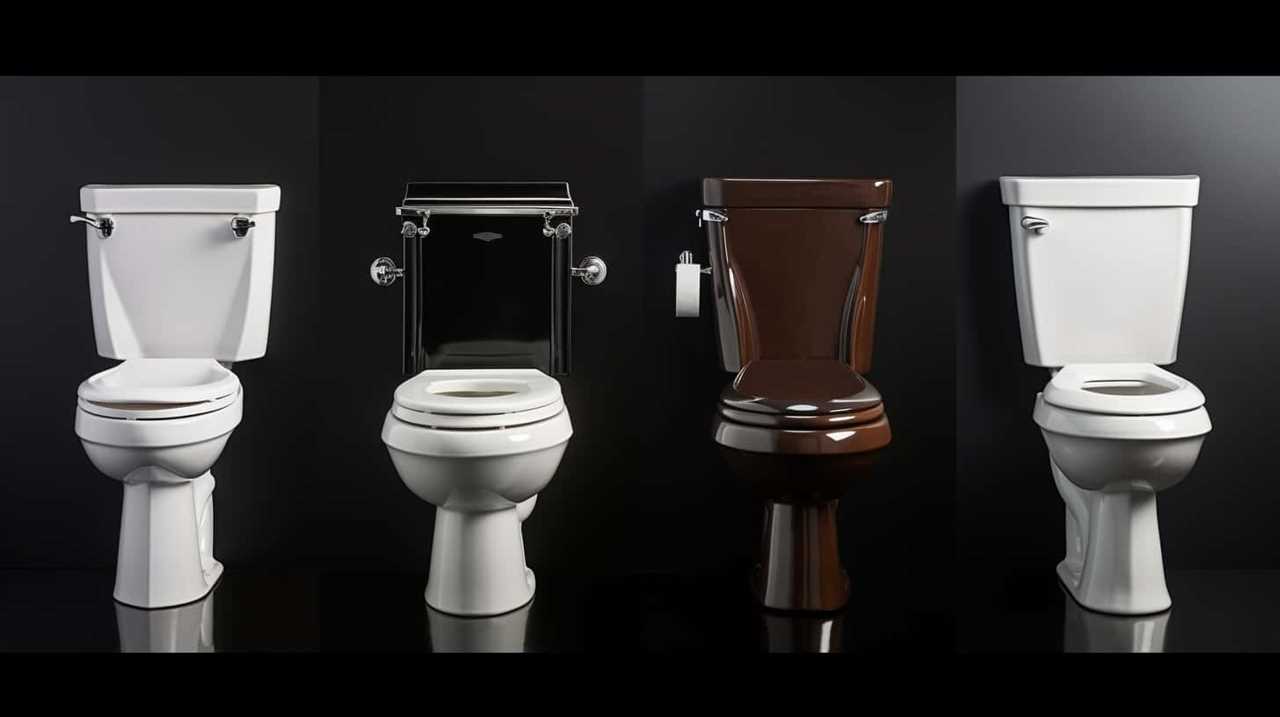
- Water pollution: Sewage contains harmful substances such as pathogens, chemicals, and nutrients that can contaminate water sources. When untreated sewage is discharged into rivers, lakes, or oceans, it can lead to water pollution, posing a threat to aquatic life and human health.
- Ecosystem disruption: The release of untreated sewage can disrupt the balance of ecosystems by introducing excessive nutrients. This can result in algal blooms, oxygen depletion, and the death of aquatic organisms, leading to a decline in biodiversity.
- Disease transmission: Untreated sewage carries pathogens that can cause diseases like cholera, dysentery, and hepatitis. If not properly managed, sewage can contaminate water supplies and spread these diseases to humans and animals.
- Habitat degradation: The accumulation of sewage in bodies of water can degrade habitats and destroy sensitive ecosystems. This can have long-term effects on the health and viability of these habitats, impacting the flora and fauna that rely on them.
Understanding the environmental impact of sewage is crucial for developing effective sewage management strategies and ensuring the protection of our water resources and ecosystems.
Underground Maze: Navigating the Pipes
As we flush the toilet, the flushed water navigates through an underground maze of pipes. This intricate network of plumbing infrastructure is designed to efficiently transport wastewater from our homes to treatment facilities. Navigating sewer tunnels, the water flows through a series of interconnected pipes, guided by gravity and the force of water pressure.
These pipes are carefully laid out, taking into account factors such as slope and diameter to ensure optimal flow. The plumbing infrastructure is designed to prevent blockages and ensure the smooth movement of wastewater. Along the way, the water may encounter various junctions, where it can be diverted to treatment plants or combined with other wastewater streams.
The underground maze of pipes plays a crucial role in managing our sewage, ensuring the safe disposal and treatment of wastewater.

From Your Home to the Main Sewer Line
Once the flushed toilet water enters the underground maze of pipes, it continues its journey from our homes to the main sewer line, propelled by the force of gravity and water pressure. This underground infrastructure is a vital part of sewage management, ensuring the proper disposal of waste.
Here is a step-by-step breakdown of how the water travels from your home to the main sewer line:
- Gravity and water pressure push the water through the pipes, guiding it towards the main sewer line.
- Along the way, the water passes through various bends and intersections in the pipe network, navigating the underground maze.
- The pipes are designed to prevent leaks and blockages, maintaining the smooth flow of water.
- Finally, the water reaches the main sewer line, where it joins the collective waste from the entire neighborhood, ready for further treatment and disposal.
Understanding this process helps us appreciate the importance of well-maintained underground infrastructure in sewage management.
Joining Forces: the Combined Sewer System
How does the flushed toilet water join forces in the combined sewer system?

In sewage management, the combined sewer system plays a crucial role in handling wastewater. This system is designed to collect not only domestic wastewater but also stormwater runoff. The aim is to prevent flooding and protect the environment by effectively managing the flow of water.
When it comes to the combined sewer system, the flushed toilet water, along with other wastewater sources, enters a network of pipes that connect to a treatment facility. However, during heavy rainfall or snowmelt, the system can become overwhelmed. This can lead to a combined sewer overflow, where excess wastewater is discharged directly into nearby bodies of water without being treated.
To mitigate this issue, cities are implementing strategies such as storage tunnels and green infrastructure to reduce the frequency and volume of combined sewer overflow events.
Making Its Way to the Treatment Plant
After entering the combined sewer system, the flushed toilet water, along with other wastewater sources, makes its way to the treatment plant through a network of pipes. Once at the treatment plant, the water undergoes a series of processes to ensure it’s clean and safe for the environment.

Here is a breakdown of what happens at the treatment plant:
- Screening: Large objects and debris are removed from the water using screens. This prevents damage to the equipment and allows for easier processing.
- Primary Treatment: The water enters settling tanks where solid particles settle to the bottom as sludge. This sludge is then removed and treated separately.
- Secondary Treatment: Biological processes are used to further break down any remaining organic matter. Bacteria and other microorganisms are added to the water, helping to remove pollutants.
- Filtration: Finally, the water is filtered through various layers to remove any remaining impurities. This ensures that the water is clean and safe before it’s discharged back into the environment.
Understanding filtration systems and the importance of proper waste disposal is crucial for maintaining a healthy and sustainable environment. By following proper waste disposal practices and supporting the treatment plant’s efforts, we can contribute to cleaner waterways and a healthier ecosystem.
The Treatment Process: Removing Impurities
As we continue the discussion from the previous subtopic, we can now delve into the treatment process of removing impurities from the flushed toilet water and other wastewater sources. This process is crucial in ensuring that the water meets the necessary water quality standards before it can be safely released back into the environment.
To achieve this, treatment plants employ several methods to remove impurities. One common technique is sedimentation, where solid particles in the water settle to the bottom, forming a layer of sludge. This sludge is then treated through a process called sewage sludge management, which involves separating liquids from solids and further treating them to minimize environmental impact.

Another method used is filtration, which involves passing the water through various layers of filters to remove smaller particles and contaminants. Additionally, disinfection processes such as chlorination or ultraviolet (UV) light are employed to kill any remaining harmful bacteria or viruses.
Bacterial Breakdown: Breaking Down Waste
When it comes to the disposal of flushed toilet water, one important aspect is the waste decomposition process.
Bacteria play a crucial role in breaking down the waste materials present in the water. These bacteria are responsible for the breakdown of organic matter into simpler compounds, such as carbon dioxide and water.
This decomposition process is essential for minimizing the environmental impact of the waste and ensuring the proper treatment of flushed toilet water.
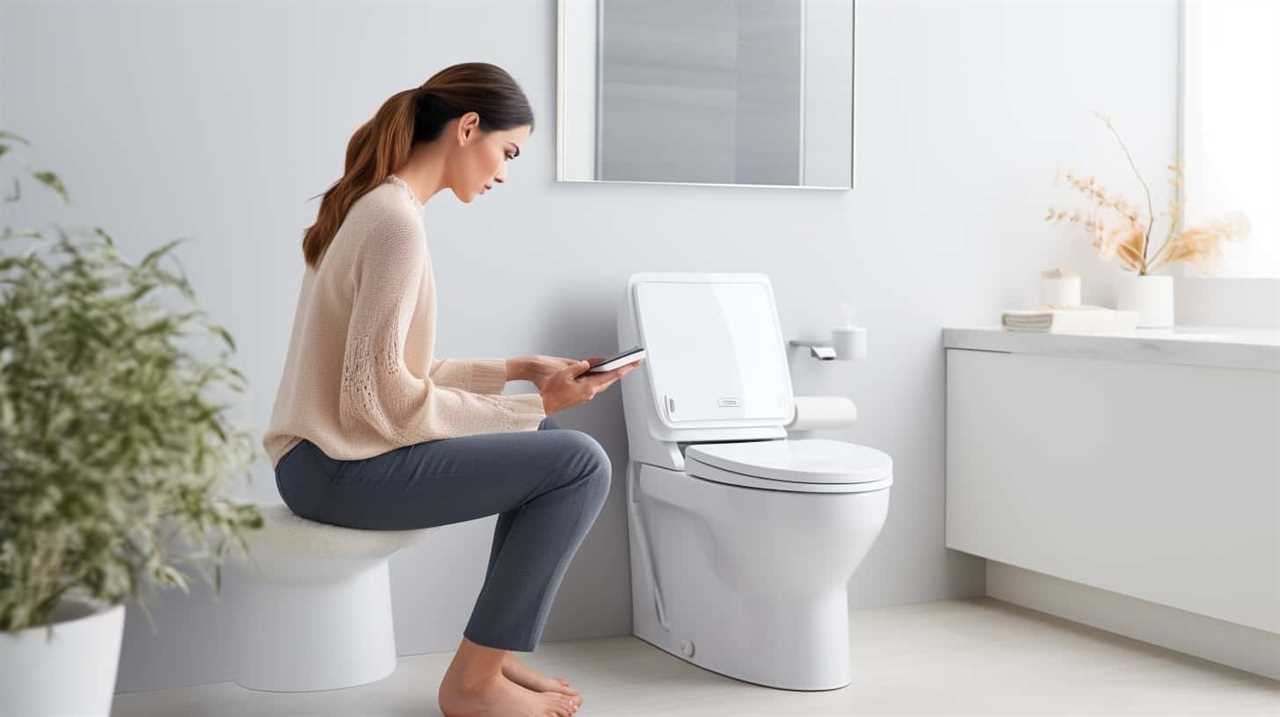
Waste Decomposition Process
During the waste decomposition process, bacteria actively break down flushed toilet water. This microbial activity plays a crucial role in waste management and ensures the effective breakdown of organic matter. Here are four key aspects of the waste decomposition process:
- Aerobic Bacteria: These bacteria require oxygen to carry out their metabolic processes. They thrive in the presence of oxygen and contribute to the initial stages of waste breakdown.
- Anaerobic Bacteria: In the absence of oxygen, anaerobic bacteria take over and continue the decomposition process. They break down complex organic compounds into simpler substances.
- Nutrient Cycling: Bacteria play a vital role in recycling essential nutrients found in waste, such as nitrogen and phosphorus. Through microbial activity, these nutrients are released back into the environment, supporting plant growth.
- Biogas Production: As bacteria decompose waste, they produce biogas, primarily composed of methane and carbon dioxide. This biogas can be captured and used as a renewable energy source.
Understanding the waste decomposition process and the role of bacteria is essential for effective waste management and sustainable resource utilization.
Role of Bacteria
Our flushed toilet water undergoes a crucial bacterial breakdown process to effectively break down waste. Bacteria play a vital role in this process, providing numerous benefits through their microbial processes.
When waste enters the sewage system, bacteria start working immediately to break down the organic matter. These bacteria, known as decomposers, release enzymes that help break down complex molecules into simpler forms. They convert organic waste into compounds such as carbon dioxide, water, and other byproducts.
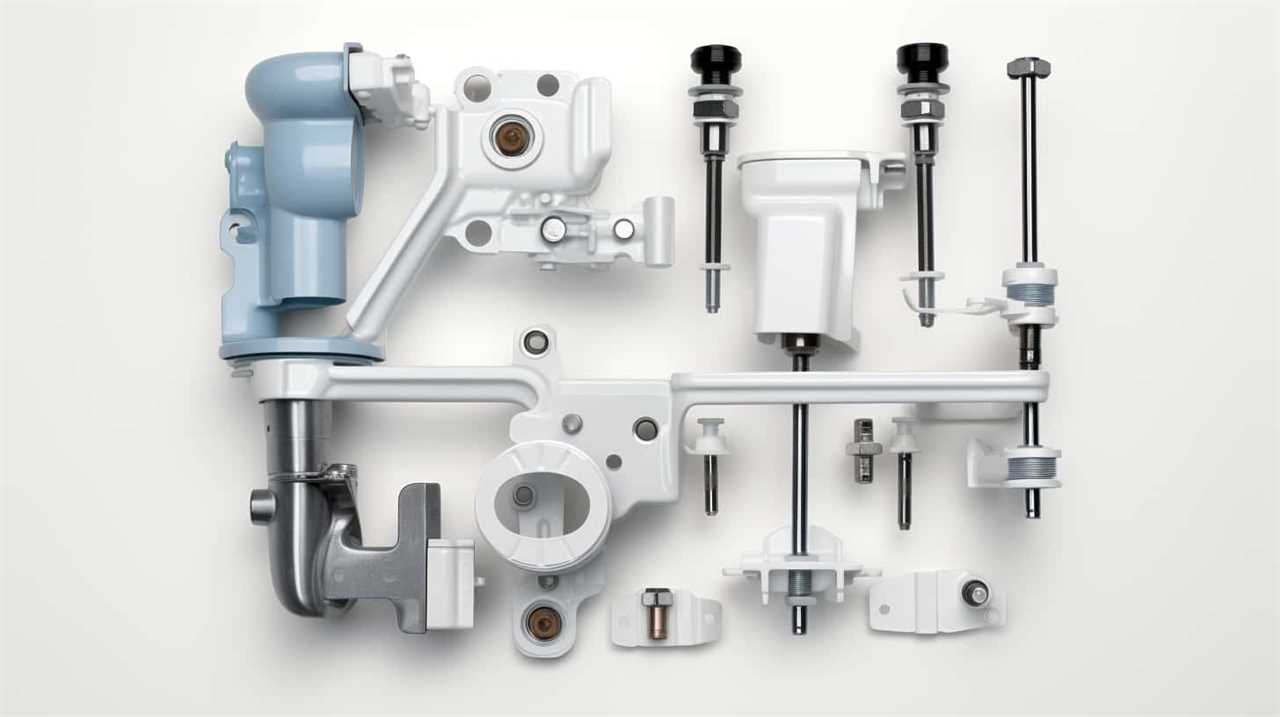
This microbial breakdown not only reduces the volume of waste but also helps to eliminate harmful pathogens and odorous substances. Bacteria also play a crucial role in nitrogen cycling, transforming nitrogen compounds into forms that can be used by plants.
Environmental Impact of Decomposition
To understand the environmental impact of bacterial breakdown in the decomposition process, we need to examine the effects of this crucial process on waste management and ecosystem health. The decomposition effects of bacterial breakdown play a significant role in waste management and have various ecological consequences. Here are four important aspects to consider:
- Nutrient recycling: Bacterial breakdown breaks down waste into simpler compounds, releasing essential nutrients like nitrogen and phosphorus back into the environment. This recycling process replenishes the soil and supports the growth of plants and other organisms.
- Energy production: Bacterial decomposition generates energy in the form of biogas, which can be harnessed for various purposes. This renewable energy source contributes to reducing dependence on fossil fuels and mitigating climate change.
- Water quality: Bacterial breakdown helps break down harmful substances present in wastewater, improving water quality and reducing pollution. This is crucial for maintaining the health of aquatic ecosystems and ensuring safe drinking water.
- Greenhouse gas emissions: Bacterial decomposition releases greenhouse gases like methane, which contribute to climate change. Proper waste management practices can help minimize these emissions and mitigate their impact on the environment.
Understanding the ecological consequences of bacterial breakdown is vital for developing sustainable waste management strategies and preserving ecosystem health.
In the next section, we’ll explore how the water is filtered to remove solids, further enhancing the treatment process.
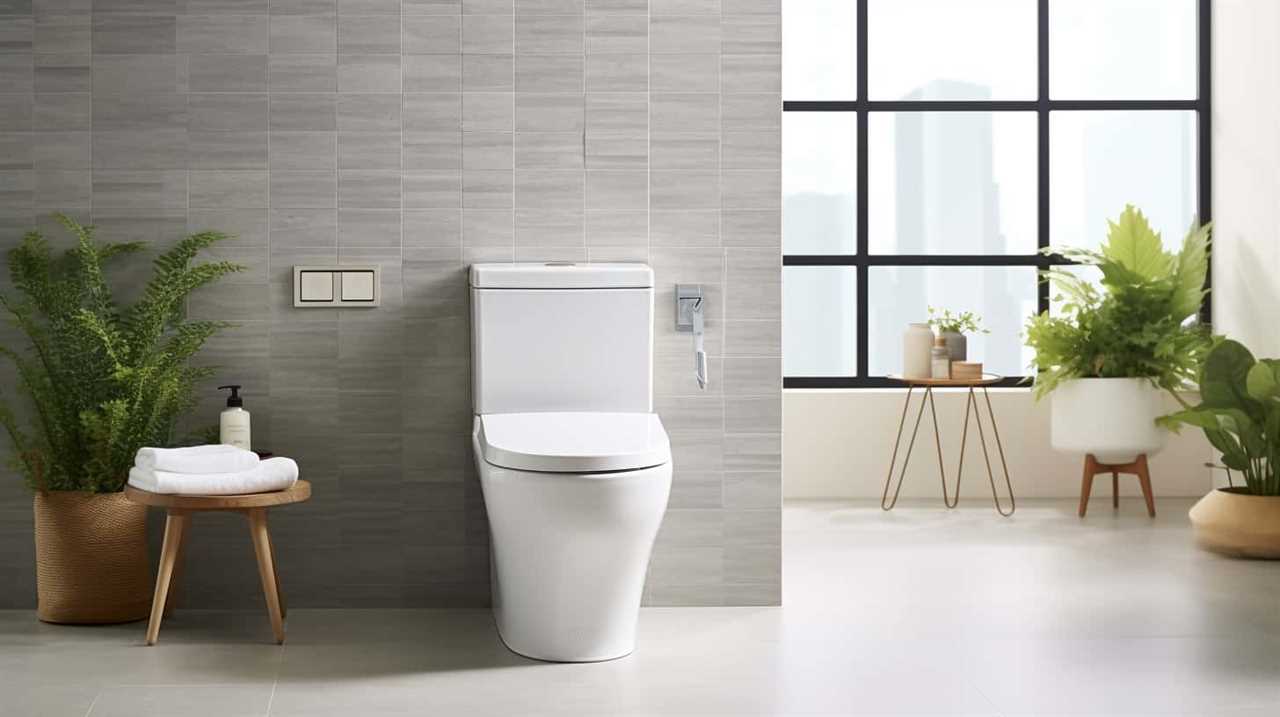
Filtering the Water: Removing Solids
After entering the sewage system, flushed toilet water undergoes a process of filtering out solids. This solids removal is an essential step in wastewater treatment to ensure the water is safe and clean before being released back into the environment.
The filtration process begins with the water passing through screens or grates, which catch large objects like toilet paper and debris. Next, the water goes through sedimentation tanks, where gravity allows heavier solids to settle at the bottom. These settled solids, known as sludge, are then removed and treated separately.
The Final Stages: Disinfection and Chlorination
Once the water has undergone the meticulous process of solids removal, we move on to the final stages of wastewater treatment: disinfection and chlorination. In this step, the goal is to eliminate any remaining pathogens and harmful microorganisms that may still be present in the water. Here are four key aspects of the disinfection process and water purification:
- Chemical disinfection: Various chemicals, such as chlorine or ozone, are added to the water to kill bacteria, viruses, and other pathogens.
- Contact time: The water is allowed to come into contact with the disinfectant for a specific period to ensure effective disinfection.
- Monitoring and testing: Regular monitoring and testing are conducted to ensure that the disinfection process is working efficiently and the water meets the required standards.
- Residual disinfection: A small amount of disinfectant is intentionally left in the water to maintain its quality throughout the distribution system.
As the disinfection process concludes, the next step will be to release the treated water back into nature.
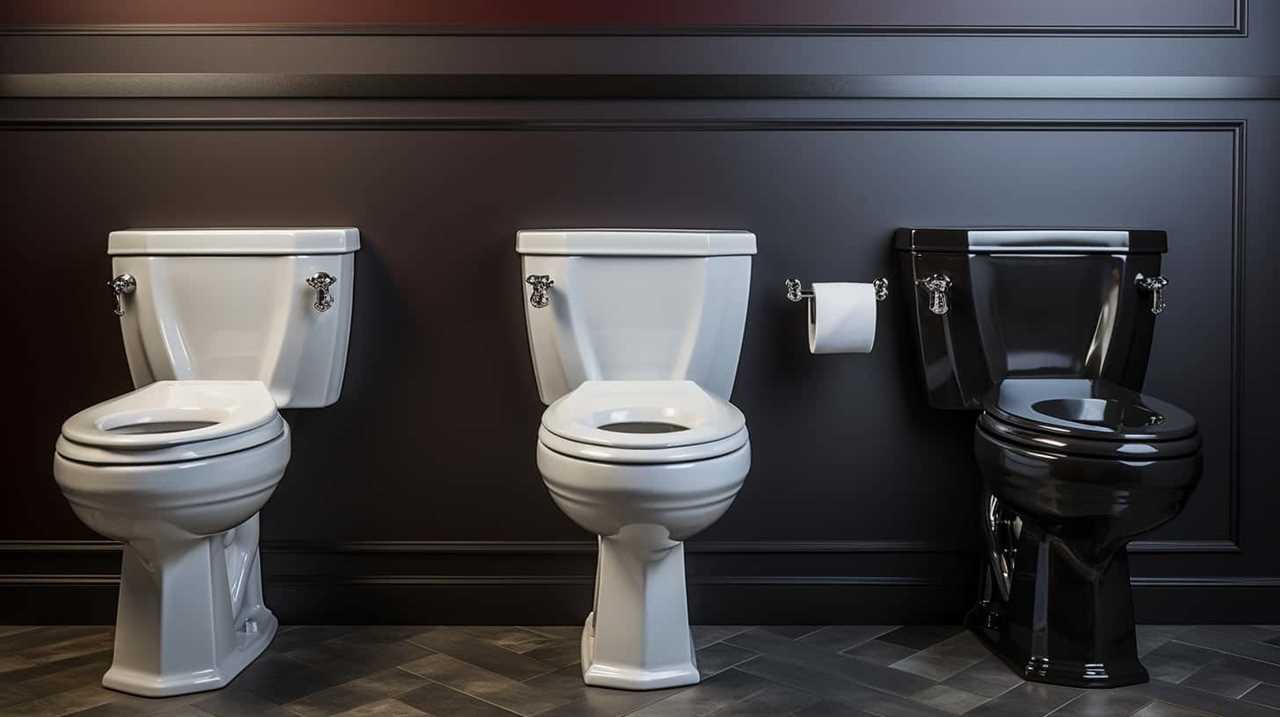
Releasing Treated Water Back Into Nature
After completing the disinfection process, we release the treated water back into nature. This step is crucial in water management and allows for water reuse, ensuring a sustainable and efficient use of this valuable resource.
The treated water is carefully discharged into a nearby water body, such as a river or an ocean, following strict guidelines and regulations. Before release, the water undergoes rigorous testing to ensure that it meets quality standards and poses no harm to the environment or human health.
The Cycle Continues: Water Conservation and Reuse
To ensure sustainable and efficient use of water, we regularly practice water conservation and reuse. Here are four key strategies we employ in our efforts towards water reclamation and sustainable water management:
- Rainwater Harvesting: We collect rainwater from rooftops and other surfaces, storing it for later use in irrigation, cleaning, and other non-potable purposes.
- Greywater Recycling: We treat and reuse water from sources such as sinks, showers, and laundry for irrigation and toilet flushing, reducing the demand on freshwater sources.
- Efficient Fixtures and Appliances: By using low-flow toilets, faucets, and showerheads, we minimize water wastage while maintaining the same level of functionality.
- Industrial Water Recycling: Industries implement advanced treatment processes to reclaim and reuse water in their operations, reducing their reliance on freshwater sources and minimizing their environmental impact.
Through these practices, we strive to conserve water resources, reduce strain on freshwater supplies, and promote sustainable water management for a more environmentally responsible future.
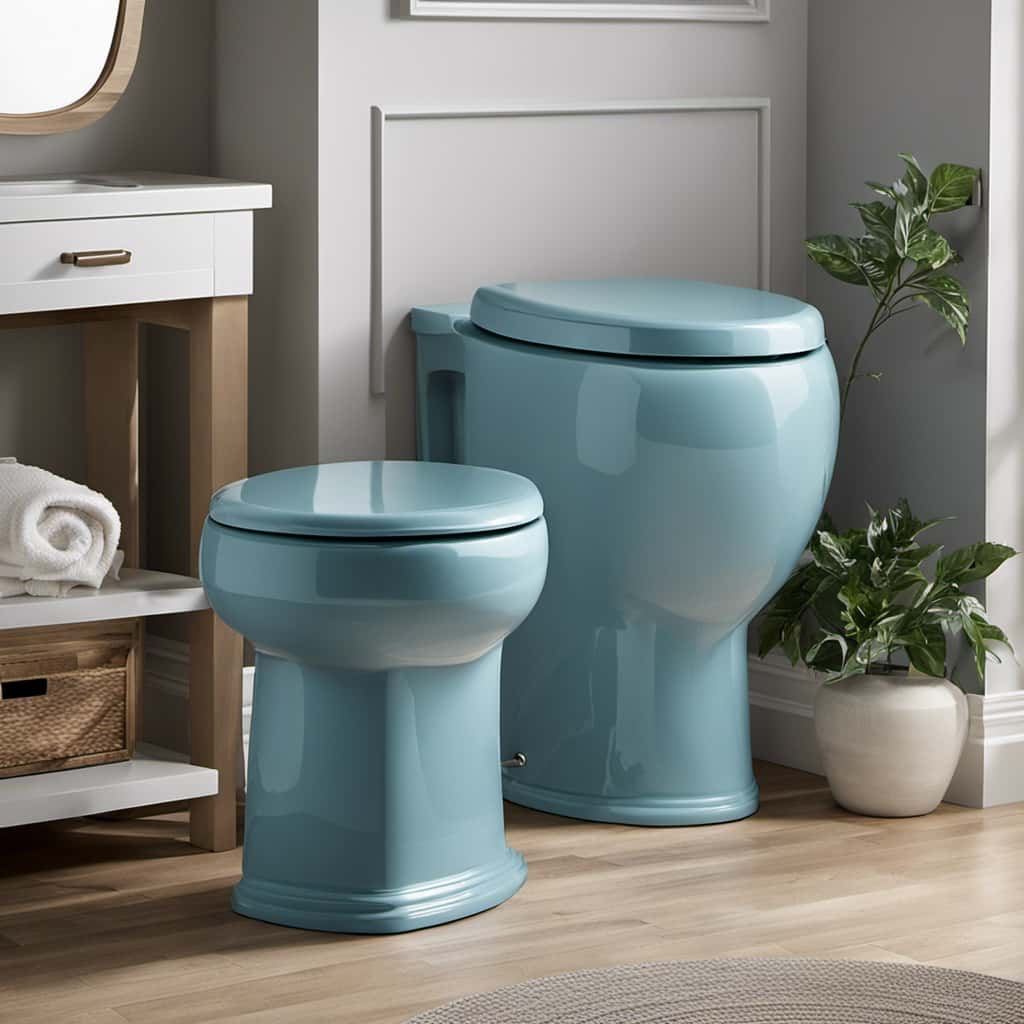
Frequently Asked Questions
How Does a Toilet Flush Actually Work?
When we flush a toilet, the flushing mechanism activates, releasing water from the tank into the bowl. This sudden surge of water creates a powerful force that pushes waste down the drain, ultimately leading to the sewage system.
What Happens to Toilet Water After It Goes Down the Drain?
Toilet water, after it’s flushed, undergoes a complex treatment process to ensure its environmental impact is minimized. Through this meticulous treatment, it is transformed into clean, safe water that can be returned to our ecosystems.
Are There Any Health Risks Associated With Flushed Toilet Water?
Flushed toilet water undergoes water treatment processes to remove harmful contaminants. This ensures that it doesn’t pose significant health risks. Additionally, proper sewage management prevents the negative impact of sewage on local ecosystems.
What Happens to the Solid Waste That Is Flushed Down the Toilet?
When solid waste is flushed down the toilet, it goes through a waste treatment process. This process involves sewage disposal, where the waste is treated and filtered to remove harmful substances before being safely discharged.

Can Flushed Toilet Water Be Reused for Other Purposes?
Reusing flushed toilet water for other purposes has numerous benefits. It conserves water, reduces strain on the environment, and saves money. Plus, it’s a win-win situation since we’re giving this "once-flushed water" a second chance!
Conclusion
And so, as the journey of flushed toilet water comes to an end, we witness the remarkable cycle of water conservation and reuse.
Through the intricate maze of pipes and the meticulous filtration process, our wastewater is transformed into clean, disinfected water.
It’s then released back into nature, ready to be used again in this ever-continuing cycle.
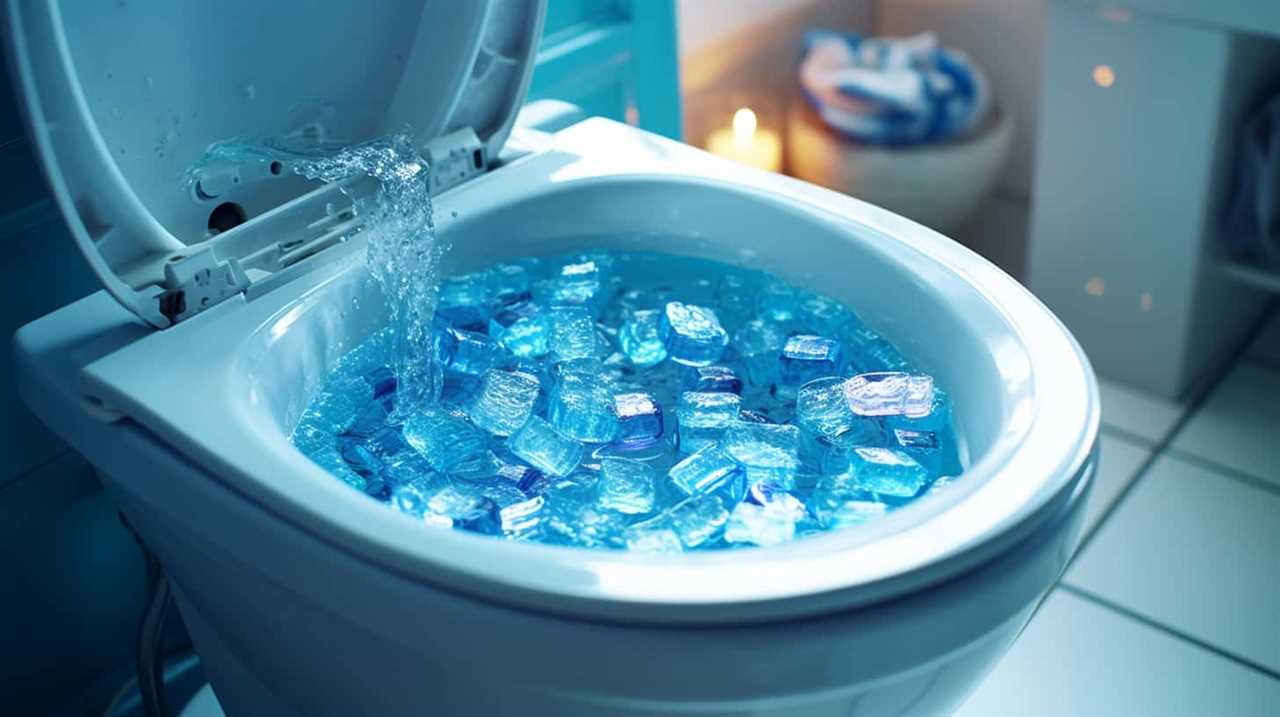
So let’s embrace this remarkable anachronism of modern technology and strive to conserve and reuse water, ensuring a sustainable future for all.



